DIYables ESP32 Web Apps Web Temperature
Overview
The WebTemperature example creates a visual thermometer interface accessible from any web browser. Designed for ESP32 educational platform with enhanced sensor monitoring capabilities, built-in temperature sensing features, and seamless integration with environmental monitoring educational modules. Perfect for monitoring temperature sensors, environmental conditions, or any temperature-based measurements requiring visual feedback.
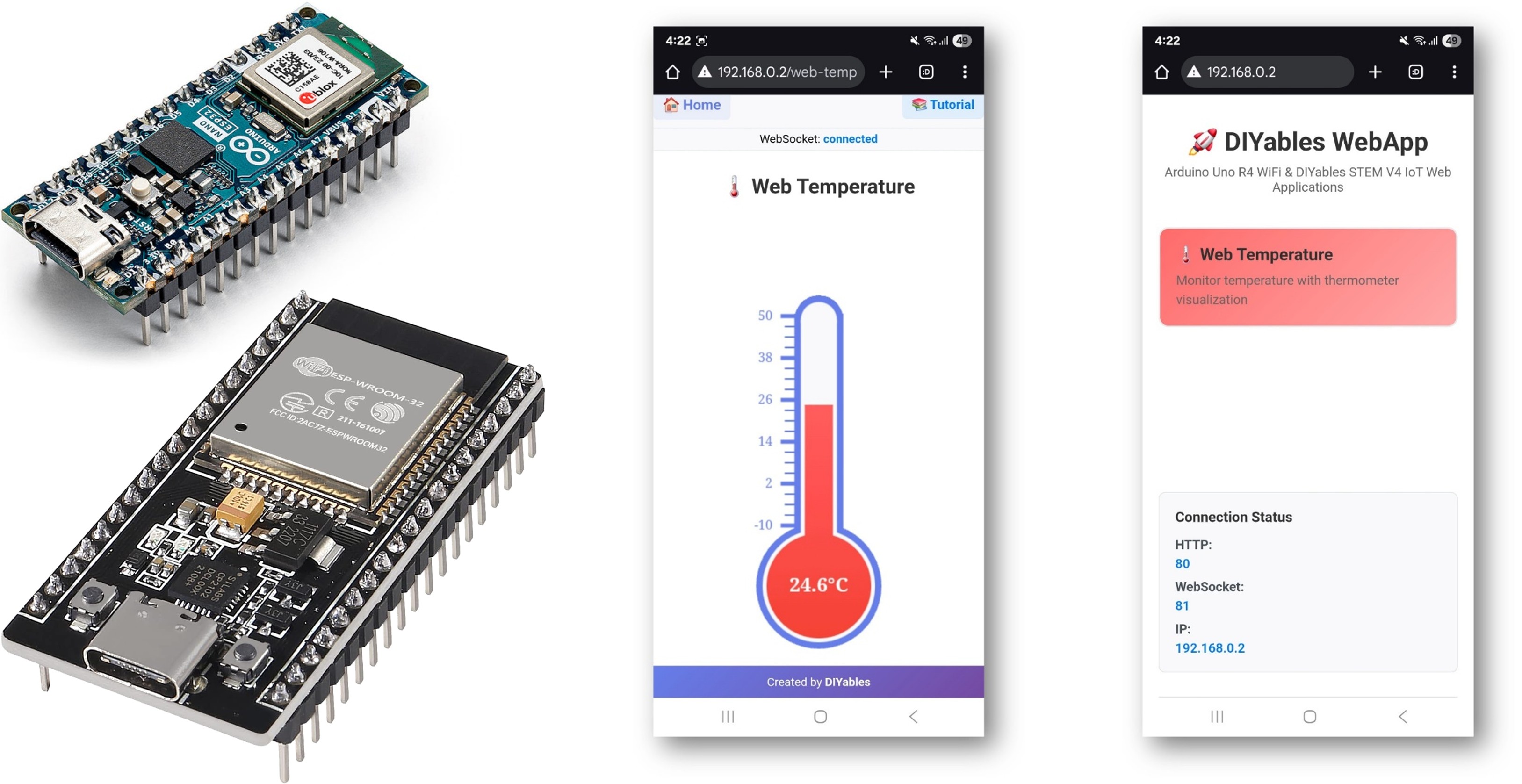
Features
- Visual Thermometer Display: Interactive thermometer via web interface
- Configurable Temperature Range: Custom minimum and maximum temperatures with units
- Real-time Updates: Live temperature display with mercury-style animation
- Multiple Units Support: Celsius (°C), Fahrenheit (°F), Kelvin (K)
- Automatic Config Handling: Set range and unit once in constructor
- WebSocket Communication: Instant updates without page refresh
- Mobile Responsive: Works perfectly on desktop, tablet, and mobile devices
- Professional Design: Clean thermometer visualization with smooth animations
Hardware Used In This Tutorial
Or you can buy the following kits:
| 1 | × | DIYables ESP32 Starter Kit (ESP32 included) | |
| 1 | × | DIYables Sensor Kit (30 sensors/displays) | |
| 1 | × | DIYables Sensor Kit (18 sensors/displays) |
Buy Note: Numerous DS18B20 sensors available in the market are of poor quality. We strongly advise purchasing the sensor from the DIYables brand via the link above; we conducted tests, and it performed reliably.
Setup Instructions
Quick Instructions
Follow these instructions step by step:
- If this is your first time using the ESP32, refer to the tutorial on setting up the environment for ESP32 in the Arduino IDE.
- Connect the ESP32 board to your computer using a USB cable.
- Launch the Arduino IDE on your computer.
- Select the appropriate ESP32 board (e.g. ESP32 Dev Module) and COM port.
- Navigate to the Libraries icon on the left bar of the Arduino IDE.
- Search "DIYables ESP32 WebApps", then find the DIYables ESP32 WebApps Library by DIYables
- Click Install button to install the library.
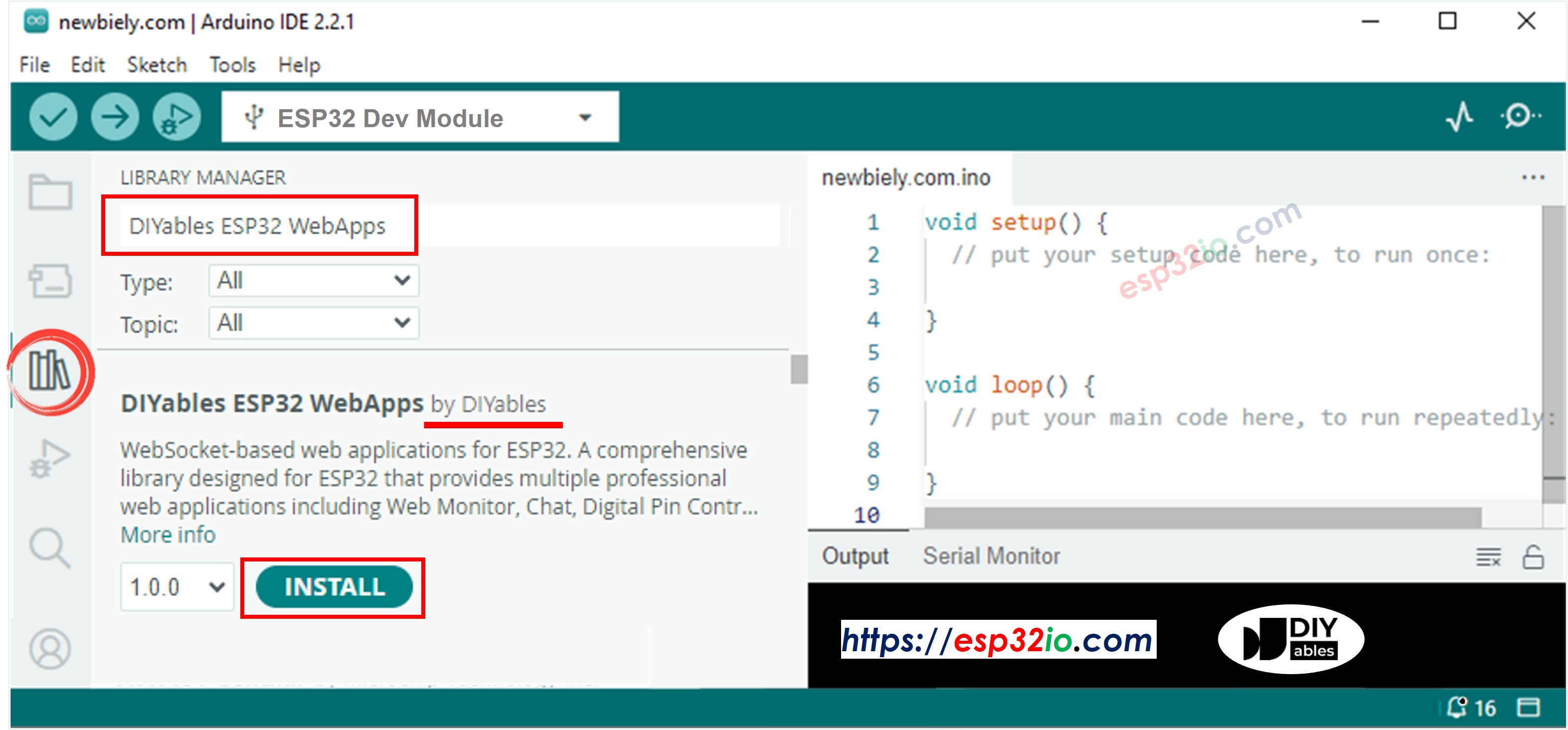
- You will be asked for installing some other library dependencies
- Click Install All button to install all library dependencies.
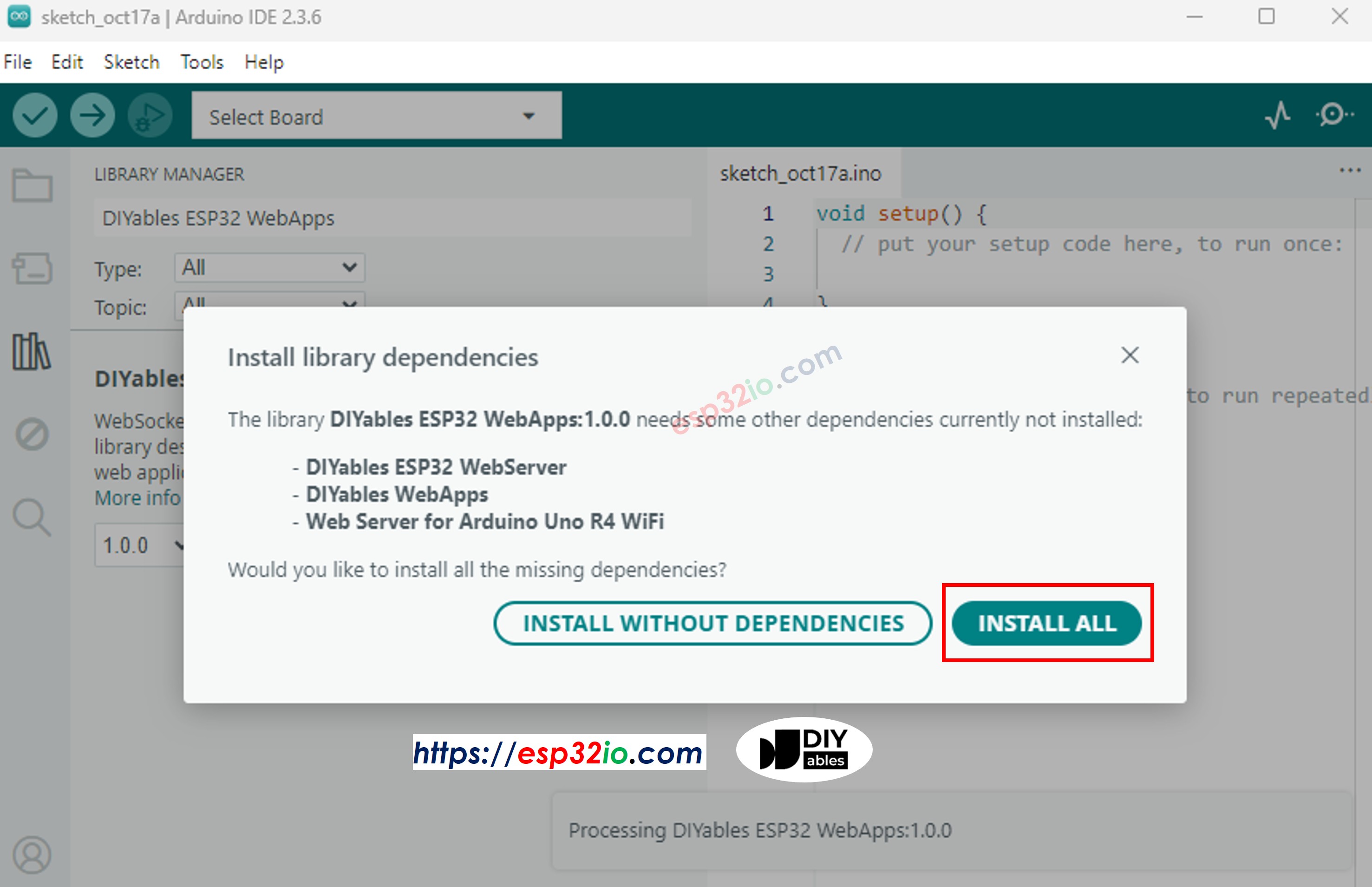
- On Arduino IDE, Go to File Examples DIYables ESP32 WebApps WebTemperature example, or copy the above code and paste it to the editor of Arduino IDE
- Configure WiFi credentials in the code by updating these lines:
- Click Upload button on Arduino IDE to upload code to ESP32
- Open the Serial Monitor
- Check out the result on Serial Monitor. It looks like the below
- If you do not see anything, reboot ESP32 board.
- Open a web browser on your PC or mobile phone.
- Type the IP address shown in the Serial Monitor to the web browser
- Example: http://192.168.1.100
- You will see the home page like below image:
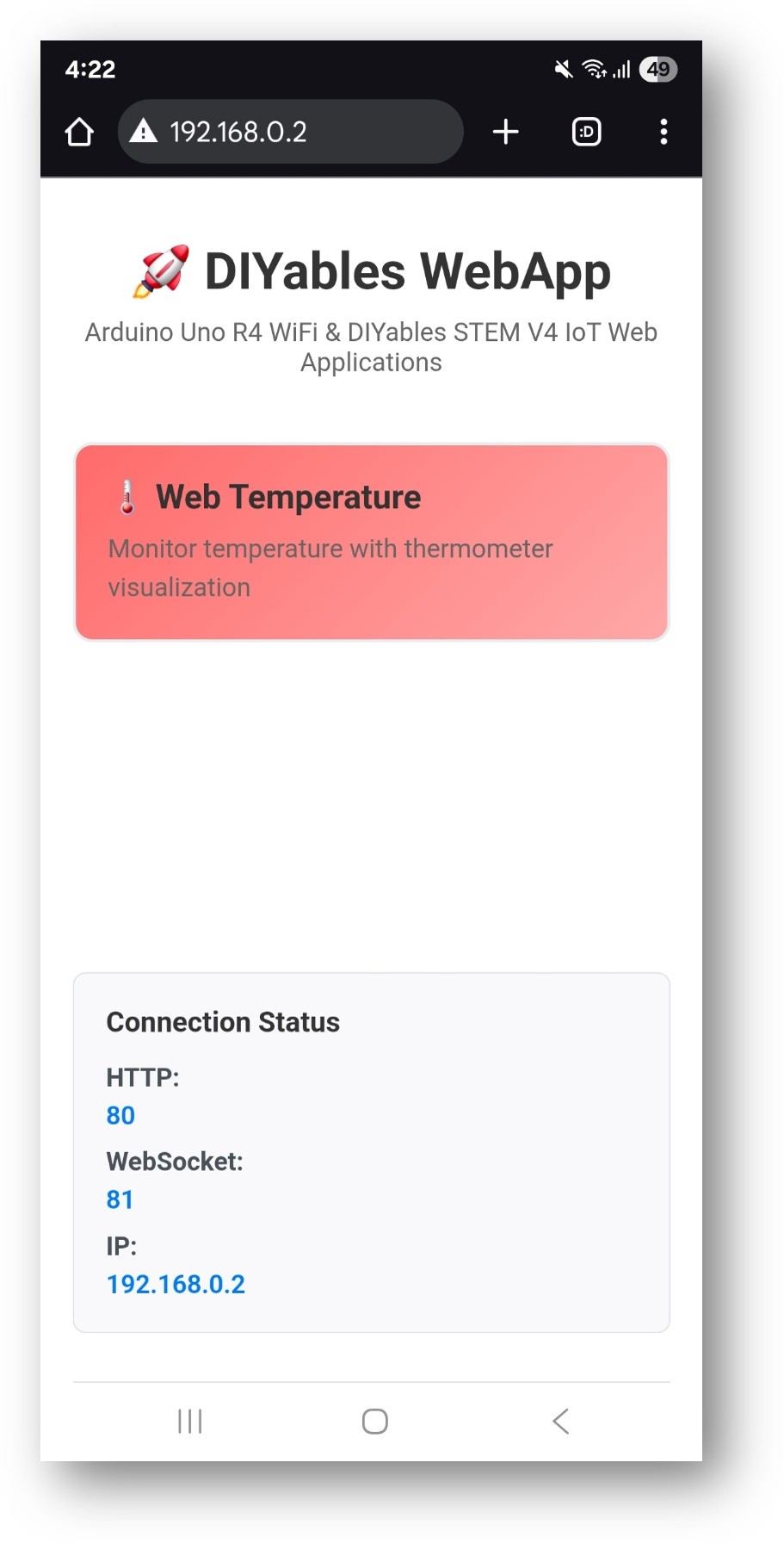
- Click to the Web Temperature link, you will see the Web Temperature app's UI like the below:
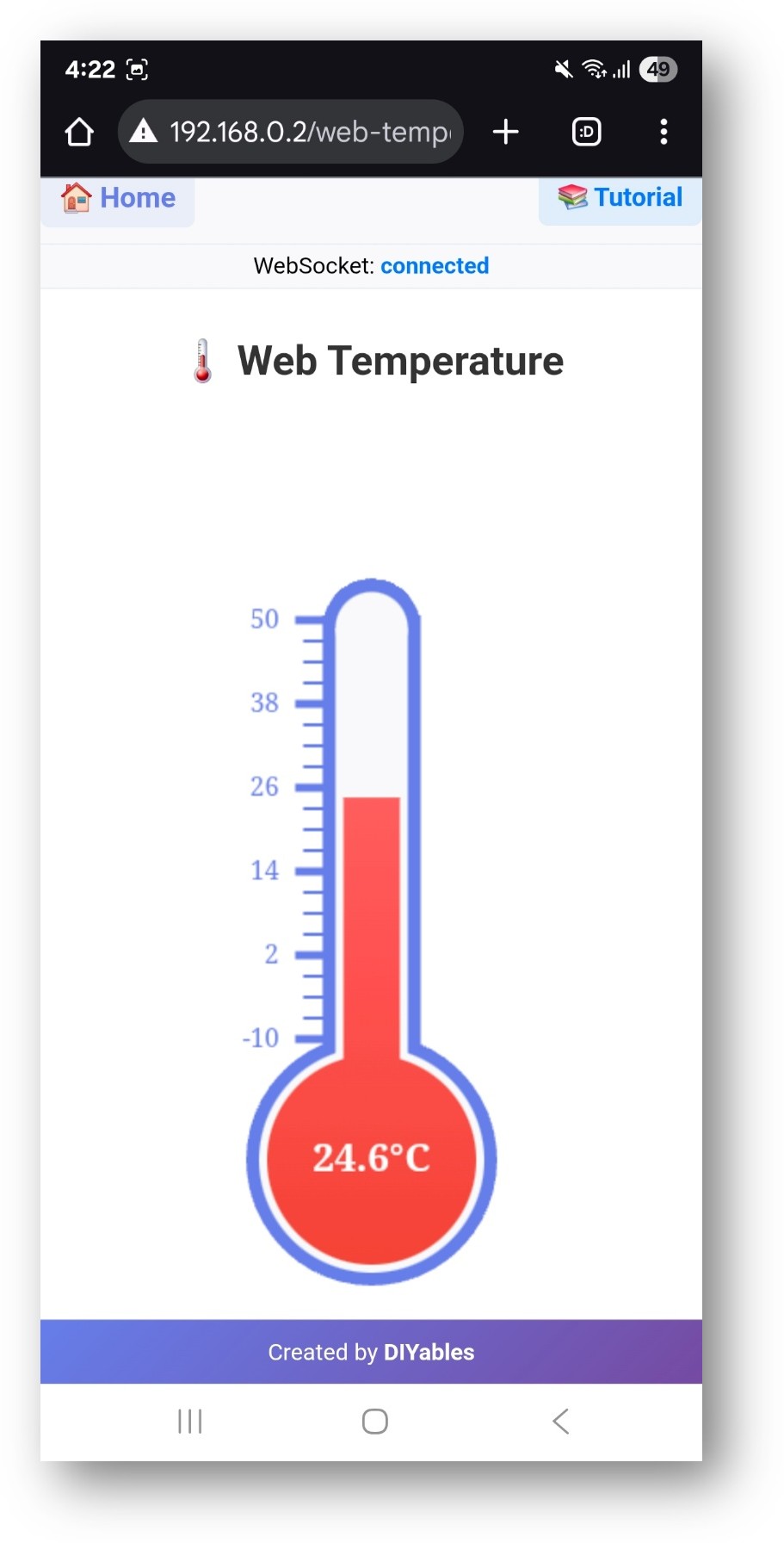
- Or you can also access the page directly by IP address followed by /web-temperature. For example: http://192.168.1.100/web-temperature
- You will see a visual thermometer display showing real-time temperature readings
Web Interface Features
Thermometer Display
- Visual Thermometer: Classic thermometer design with mercury-style animation
- Temperature Scale: Clear scale markings with configurable range
- Real-time Updates: Live temperature display with smooth transitions
- Unit Display: Shows configured temperature units (°C, °F, K)
- Professional Design: Clean, educational-style thermometer visualization
Real-time Monitoring
- Live Data: Temperature updates automatically via WebSocket connection
- Smooth Animation: Mercury level moves smoothly between readings
- Status Feedback: Connection status indicator
- Mobile Optimized: Touch-friendly interface for all devices
Code Configuration
Temperature Setup
Sending Temperature Values
Temperature Sensor Integration
DS18B20 Digital Temperature Sensor
DHT22 Temperature/Humidity Sensor
Analog Temperature Sensor (TMP36)
Unit Conversion
Supporting Multiple Units
Customization Options
Temperature Range
- Minimum Temperature: Set lowest expected reading
- Maximum Temperature: Set highest expected reading
- Units: Display unit string (°C, °F, K, or custom)
- Scale: Thermometer scale automatically adjusts to range
Update Frequency
Common Use Cases
Educational Projects
- Weather Monitoring: Indoor/outdoor temperature tracking
- Physics Experiments: Heat transfer, thermal dynamics
- Environmental Science: Climate monitoring, greenhouse control
- Electronics Learning: Sensor interfacing, data visualization
Practical Applications
- Home Automation: HVAC control, energy monitoring
- Greenhouse Control: Plant growth optimization
- Food Safety: Temperature monitoring for storage
- Industrial: Process monitoring, quality control
Troubleshooting
Temperature Not Updating
- Check WiFi connection and WebSocket status
- Verify sensor wiring and power supply
- Ensure callback function is properly set
- Check Serial Monitor for sensor readings
Incorrect Temperature Values
- Verify sensor calibration and accuracy
- Check voltage reference for analog sensors
- Ensure proper sensor initialization
- Test sensor independently with basic code
Sensor Connection Issues
- Check wiring connections (power, ground, data)
- Verify pull-up resistors for digital sensors
- Test sensor with multimeter for proper operation
- Check sensor library installation and compatibility
Advanced Features
Multiple Temperature Sensors
Monitor multiple locations with separate thermometers:
Temperature Logging
Combine with Web Plotter for historical temperature data:
Alert System
Implement temperature alerts:
Educational Integration
STEM Learning Objectives
- Temperature Physics: Understanding thermal concepts
- Sensor Technology: Learning digital and analog sensors
- Data Visualization: Real-time data display techniques
- Programming: Callback functions, sensor integration
Classroom Activities
- Sensor Comparison: Compare different temperature sensor types
- Calibration Exercise: Learn measurement accuracy principles
- Environmental Monitoring: Track temperature changes over time
- System Integration: Combine with other environmental sensors
Science Experiments
- Heat Transfer: Monitor temperature changes during experiments
- Phase Changes: Observe temperature during melting/boiling
- Insulation Testing: Compare insulation effectiveness
- Climate Study: Long-term temperature monitoring
This example provides a comprehensive foundation for temperature monitoring and visualization, perfect for both educational and practical environmental monitoring applications.
